Frigidaire FAQE7011LW, FAQE7011LB Installation Guide

All about the
Installation
of your Dryer
TA B L E O F C O N T E N T S
Important Safety Instructions |
..............................2-3 |
Reversing Door .............................................. |
18-21 |
Installation Requirements ................................. |
4-10 |
Accessories......................................................... |
22 |
Installed Dryer Dimensions .................................. |
11 |
Español .............................................................. |
23 |
Installation Instructions .................................. |
12-17 |
|
|
<![endif]>(1004) 137338300A
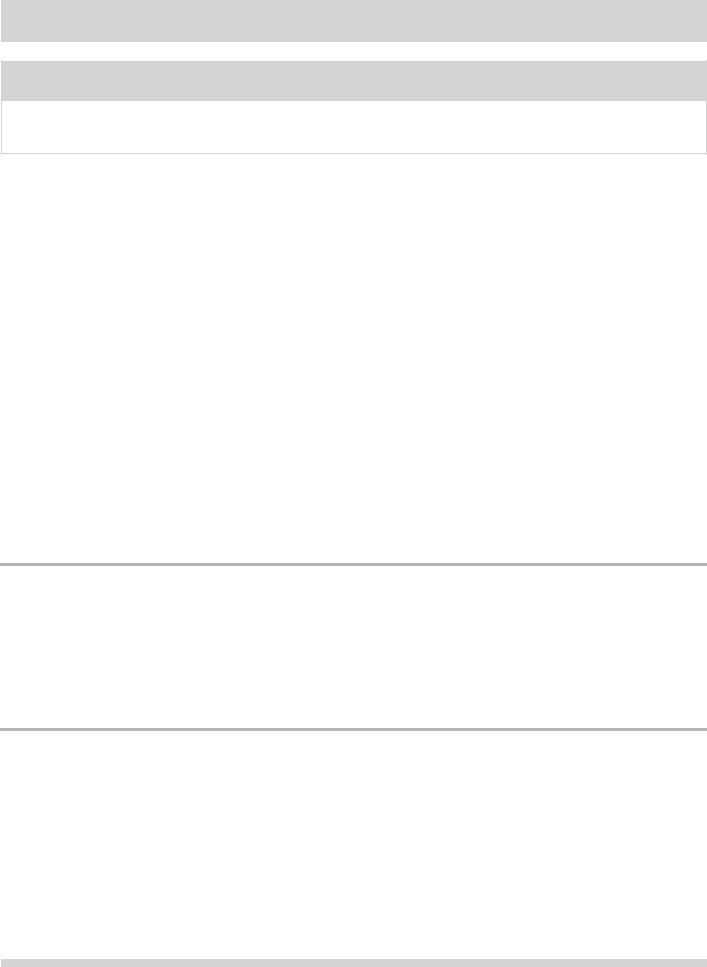
IMPORTANT SAFETY INSTRUCTIONS

 WARNING
WARNING
For your safety the information in this manual must be followed to minimize the risk of fire or explosion or to prevent property damage, personal injury or loss of life. Do not store or use gasoline or other flammable vapors and liquids in the vicinity of this or any other appliance.
 WARNING - RISK OF FIRE
WARNING - RISK OF FIRE
Read all of the following instructions before installing and using this appliance:
•Destroy the carton and plastic bags after the dryer is unpacked. Children might use them for play. Cartons covered with rugs, bedspreads, or plastic sheets can become airtight chambers causing suffocation. Place all materials in a garbage container or make materials inaccessible to children.
•Clothes dryer installation and service must be performed by a qualified installer, service agency or the gas supplier.
•Install the clothes dryer according to the manufacturer’s instructions and local codes.
•The electrical service to the dryer must conform with local codes and ordinances and the latest edition of the National Electrical Code, ANSI/NFPA 70, or in Canada, the Canadian electrical code C22.1 part 1.
•The gas service to the dryer must conform with local codes and ordinances and the latest edition of the National Fuel Gas Code ANSI Z223.1, or in Canada, CAN/ACG B149.1-2000.
•The dryer is designed under ANSI Z 21.5.1 or ANSI/UL 2158 - CAN/CSA C22.2 No. 112 (latest editions) for HOME USE only. This dryer is not recommended for commercial applications such as restaurants, beauty salons, etc.
•Do not install a clothes dryer with flexible plastic venting material. Flexible venting materials are known to collapse, be easily crushed and trap lint. These conditions will obstruct clothes dryer airflow and increase the risk of fire.
•Do not stack a dryer on top of washer already installed on pedestal. Do not stack washer on top of dryer. Do not stack washer on top of another washer.
•The instructions in this manual and all other literature included with this dryer are not meant to cover every possible condition and situation that may occur. Good safe practice and caution MUST be applied when installing, operating and maintaining any appliance.
WHAT TO DO IF YOU SMELL GAS:
•Do not try to light any appliance.
•Do not touch any electrical switch; do not use any phone in your building.
•Clear the room, building or area of all occupants.
•Immediately call your gas supplier from a neighbor’s phone. Follow the gas supplier’s instructions.
•If you cannot reach your gas supplier, call the fire department.
Save these instructions for future reference.
Pre-Installation Requirements
Tools and materials needed for installation:
• Adjustable pliers |
• Carpenter’s level |
• Gas line shutoff valve (gas dryer) |
• Phillips, straight, & square bit |
• External vent hood |
• ½ NPT union flare adapters (x2) |
screwdrivers |
• 4-inch (102 mm), rigid metal or |
and flexible gas supply line (gas |
• Adjustable wrench |
semi-rigid metal exhaust duct work |
dryer) |
• Pipe wrench for gas supply (gas |
• 3-wire or 4-wire 240 volt cord kit |
• Metal foil tape (not duct tape) |
dryer) |
(electric dryer) |
|
• LP-resistant thread tape (for natu- |
• 4 in. (10.2 cm) clamp |
|
ral gas or LP supply, gas dryer) |
|
|
2
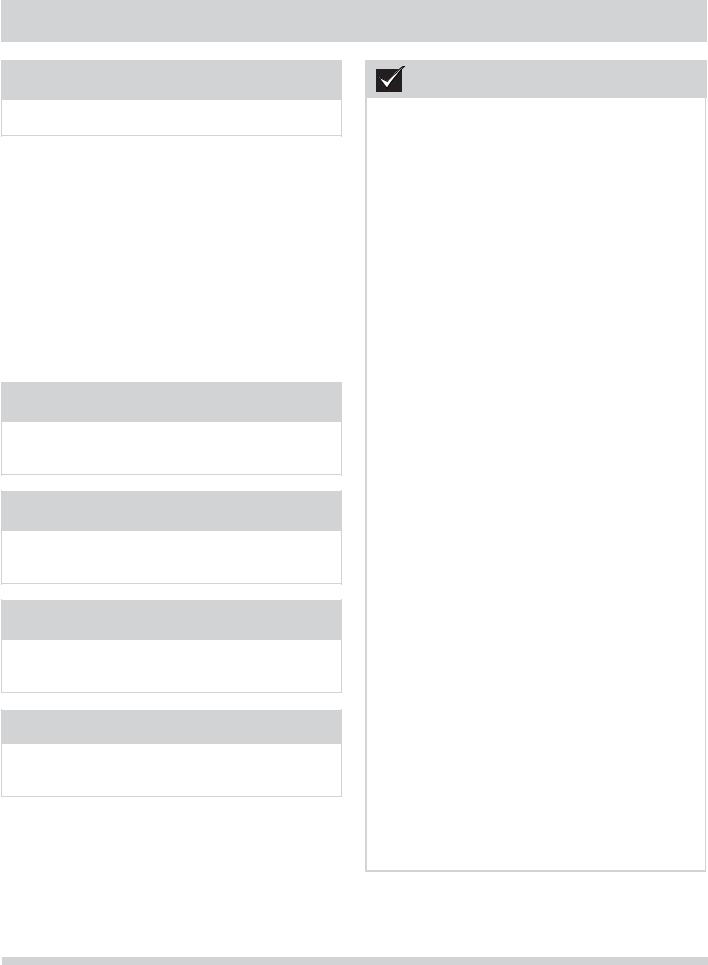
IMPORTANT SAFETY INSTRUCTIONS

 WARNING
WARNING
Please read all instructions before using this dryer.
Recognize safety symbols, words and labels
Safety items throughout this manual are labeled with a WARNING or CAUTION based on the risk type as described below:
Definitions
 This is the safety alert symbol. It is used to alert you to potential personal injury hazards. Obey all safety
This is the safety alert symbol. It is used to alert you to potential personal injury hazards. Obey all safety
messages that follow this symbol to avoid possible injury or death.

 DANGER
DANGER
DANGER indicates an imminently hazardous situation which, if not avoided, will result in death or serious injury.
Installation Checklist
Exhaust Venting
Free-flowing, clear of lint buildup
4 inch (102 mm) rigid or semi-rigid ducting of minimal length and turns
NO foil or plastic venting material
Approved vent hood exhausted to outdoors
Leveling
Dryer is level, side-to-side and front-to-back
Cabinet is setting solid on all corners
Gas Supply (Gas Dryer)
Manual shutoff valve present in supply
All connections sealed with approved sealer and wrench tight
Conversion kit for LP system
Gas supply turned on
No leaks present at all connections - check with soapy water, NEVER check with flame

 WARNING
WARNING
WARNING indicates a potentially hazardous situation which, if not avoided, could result in death or serious injury.

 CAUTION
CAUTION
CAUTION indicates a potentially hazardous situation which, if not avoided, may result in minor or moderate injury.

 IMPORTANT
IMPORTANT
IMPORTANT indicates installation, operation or maintenance information which is important but not hazard-related.
240v Electric Supply (Electric Dryer)
Approved NEMA 10-30R or 14-30R service cord with all screws tight on terminal block
Approved strain relief installed
Terminal access cover installed before initial operation
Door Reversal
Follow detailed instructions in this guide
Test hinge and latch for function
Electrical Power
House power turned on
Dryer plugged in
Final Checks
Installation Instructions and Use and Care Guide read thoroughly
Door latches and drum tumbles when cycle starts
Registration card sent in
3
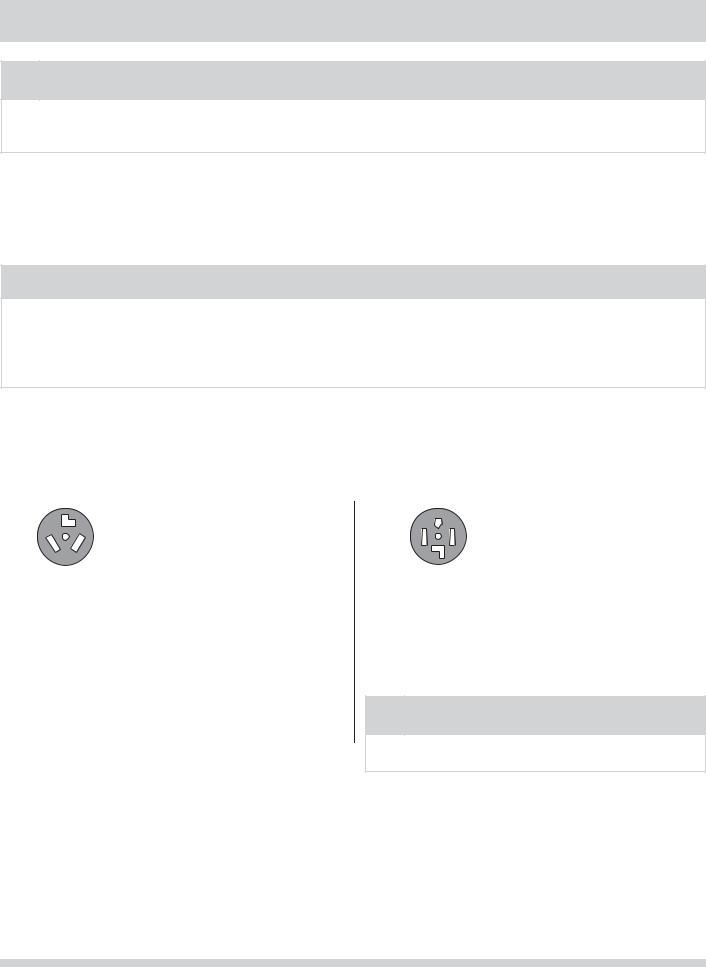
INSTALLATION REQUIREMENTS
NOTE
Because of potentially inconsistent voltage capabilities, the use of this dryer with power created by gas powered generators, solar powered generators, wind powered generators or any other generator other than the local utility company is not recommended.
Electrical requirements for electric dryer
CIRCUIT - Individual 30 amp. branch circuit fused with 30 amp. time delay fuses or circuit breakers. Use separately fused circuits for washer and dryer. DO NOT operate a washer and a dryer on the same circuit.
POWER SUPPLY - 3-wire or 4-wire, 240 volt, single phase, 60 Hz, Alternating Current.

 IMPORTANT
IMPORTANT
This dryer is internally grounded to neutral unless it was manufactured for sale in Canada.
Only a 4-conductor cord shall be used when the appliance is installed in a location where grounding through the neutral conductor is prohibited. Grounding through the neutral link is prohibited for: (1) new branch circuit
installations, (2) mobile homes, (3) recreational vehicles, and (4) areas where local codes do not permit grounding through the neutral.
OUTLET RECEPTACLE - NEMA 10-30R or NEMA 14-30R receptacle to be located so the power supply cord is accessible when the dryer is in the installed position.
GROUNDING CONNECTION - See “Grounding requirements” in Electrical Installation section.
3-WIRE POWER SUPPLY CORD KIT (not supplied) |
4-WIRE POWER SUPPLY CORD KIT (not supplied) |
3-wire receptacle (NEMA type 10-30R)
The dryer MUST employ a 3-conductor power supply cord NEMA 10-30 type SRDT rated at 240 volt AC minimum, 30 amp, with 3 open end spade lug connectors with upturned ends or closed
loop connectors and marked for use with clothes dryers. For 3-wire cord connection instructions see ELECTRICAL CONNECTIONS FOR A 3-WIRE SYSTEM.
4-wire receptacle (NEMA type 14-30R)
The dryer MUST employ a 4-conductor power supply cord NEMA 14-30 type SRDT or ST (as required) rated at 240 volt AC minimum, 30 amp, with 4 open end spade lug connectors with upturned ends or closed loop connectors and marked for use with clothes dryers. For 4-wire cord connection instructions see ELECTRICAL CONNECTIONS FOR A 4-WIRE SYSTEM.
NOTE
Dryers manufactured for sale in Canada have factoryinstalled, 4-wire power supply cord (NEMA 14-30R).
4

INSTALLATION REQUIREMENTS
Electrical requirements for gas dryer
CIRCUIT - Individual, properly polarized and grounded 15 amp. branch circuit fused with 15 amp. time delay fuse or circuit breaker.
POWER SUPPLY - 2-wire, with ground, 120 volt, single phase, 60 Hz, Alternating Current.
POWER SUPPLY CORD - The dryer is equipped with a 120 volt 3-wire power cord.
GROUNDING CONNECTION - See “Grounding requirements” in Electrical Installation section.
Grounding type wall receptacle
Do not, under
any circumstances, cut, remove,
or bypass the grounding prong.
Power cord with 3-prong grounded plu
Gas supply requirements

 WARNING
WARNING
EXPLOSION HAZARD
Uncoated copper tubing will corrode when subjected to natural gas, causing gas leaks. Use ONLY black iron, stainless steel, or plastic-coated brass piping for gas supply.
1Installation MUST conform with local codes, or in the absence of local codes, with the National Fuel Gas Code, ANSI Z223.1 (latest edition).
2The gas supply line should be 1/2 inch (1.27 cm) pipe.
3If codes allow, flexible metal tubing may be used to connect your dryer to the gas supply line. The tubing MUST be constructed of stainless steel or plastic-coated brass.
4The gas supply line MUST have an individual shutoff valve.
5A 1/8 inch (0.32 cm) N.P.T. plugged tapping, accessible for test gauge connection, MUST be installed immediately upstream of the gas supply connection to the dryer.
6The dryer MUST be disconnected from the gas supply piping system during any pressure testing of the gas supply piping system at test pressures in excess of 1/2 psig (3.45 kPa).
7The dryer MUST be isolated from the gas supply piping system during any pressure testing of the gas supply piping system at test pressures equal to or less than 1/2 psig (3.45 kPa).
8Connections for the gas supply must comply with the Standard for Connectors for Gas Appliances, ANSI Z21.24.
5

INSTALLATION REQUIREMENTS
Exhaust system requirements
Use only 4 inch (102 mm) diameter rigid or flexible metal duct and approved vent hood which has a swing-out damper(s) that open when the dryer is in operation. When the dryer stops, the dampers automatically close to prevent drafts and the entrance of insects and rodents. To avoid restricting the outlet, maintain a minimum of 12 inches (30.5 cm) clearance between the vent hood and the ground or any other obstruction.

 WARNING
WARNING
FIRE HAZARD
Failure to follow these instructions can create excessive drying times and fire hazards.
The following are specific requirements for proper and safe operation of your dryer.

 WARNING
WARNING
FIRE HAZARD
Do not install a clothes dryer with flexible plastic or metal foil venting materials. Flexible venting materials are known to collapse, be easily crushed and trap lint. These conditions will obstruct clothes dryer airflow and increase the risk of fire.
If your present system is made up of plastic duct or metal foil duct, replace it with a rigid or semi-rigid metal duct. Also, ensure the present duct is free of any lint prior to installing dryer duct.
Correct |
Incorrect |
Correct |
Incorrect |
6

INSTALLATION REQUIREMENTS
Exhaust system requirements, continued

 WARNING
WARNING
FIRE HAZARD
A clothes dryer must be exhausted outdoors. Do not exhaust dryer into a chimney, a wall, a ceiling, an attic, a crawl space or any concealed space of a building. A clothes dryer produces combustible lint. If the dryer is not exhausted outdoors, some fine lint will be expelled into the laundry area. An accumulation of lint in any area of the home can create a health and fire hazard.
The dryer must be connected to an exhaust outdoors. Regularly inspect the outdoor exhaust opening and remove any accumulation of lint around the outdoor exhaust opening and in the surrounding area.

 WARNING
WARNING
FIRE HAZARD
•Do not allow combustible materials (for example: clothing, draperies/curtains, paper) to come in contact with exhaust system. The dryer MUST NOT be exhausted into a chimney, a wall, a ceiling,
or any concealed space of a building which can accumulate lint, resulting in a fire hazard.
•Do not screen the exhaust ends of the vent system, or use any screws, rivets or other fasteners that extend into the duct to assemble the exhaust system. Lint can become caught in the screen, on the screws or rivets, clogging the duct work and creating a fire hazard as well as increasing drying times. Use an approved vent hood to terminate the duct outdoors, and seal all joints with metal foil duct tape. All male duct pipe fittings MUST be installed downstream with the flow of air.

 WARNING
WARNING
FIRE HAZARD
Exceeding the length of duct pipe or number of elbows allowed in the “MAXIMUM LENGTH” charts can cause an accumulation of lint in the exhaust system. Plugging the system could create a fire hazard, as well as increase drying times.
|
|
|
MAXIMUM LENGTH |
|
| <![if ! IE]> <![endif]>Number |
|
of 4” (102mm) Rigid Metal Duct |
||
|
|
VENT HOOD TYPE |
|
|
|
(Preferred) |
|
||
| <![if ! IE]> <![endif]>90° of |
|
|
|
|
| <![if ! IE]> <![endif]>turns |
4” |
|
|
2.5” |
|
|
|
||
|
(10.2cm) |
louvered |
(6.35cm) |
|
0 |
|
64 ft. (19.5 m) |
48 ft. (14.6 m) |
|
1 |
|
52 ft. (15.9 m) |
40 ft. (12.2 m) |
|
2 |
|
44 ft. (13.5 m) |
32 ft. (9.8 m) |
|
3 |
|
32 ft. (9.8 m) |
24 ft. (7.3 m) |
|
4 |
|
28 ft. (9.5 m) |
16 ft. (4.9 m) |
|

 WARNING
WARNING
FIRE HAZARD
•Do not install flexible plastic or flexible foil venting material.
•If installing semi-rigid venting, do not exceed 8 ft. (2.4 m) duct length.
7
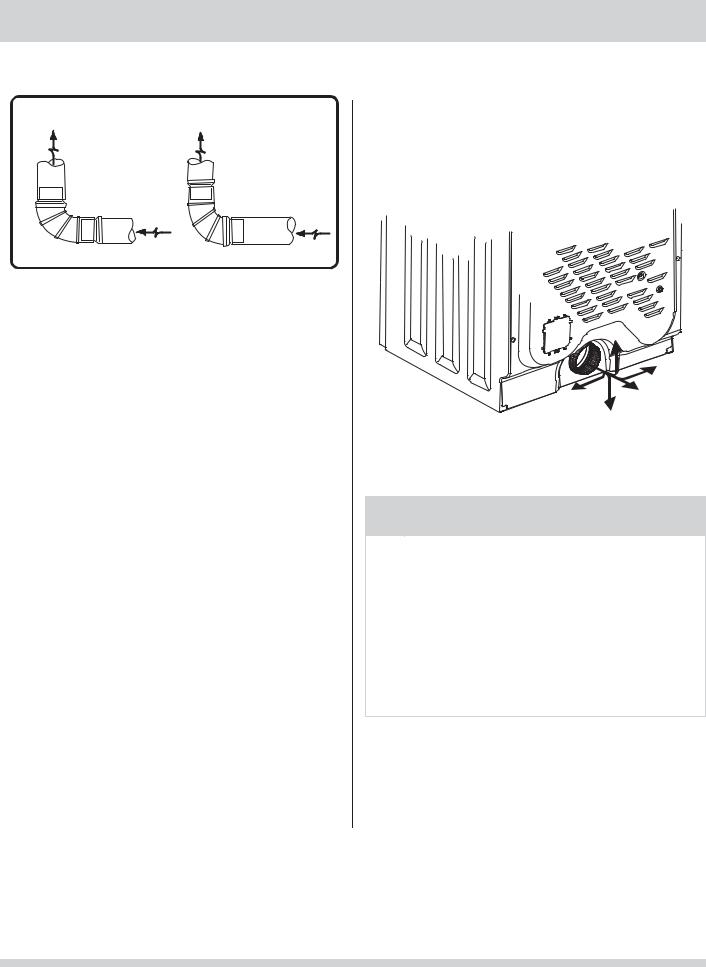
INSTALLATION REQUIREMENTS
Exhaust system requirements, continued
Install male fittings in correct direction:
CORRECT |
INCORRECT |
In installations where the exhaust system is not described in the charts, the following method must be used to determine if the exhaust system is acceptable:
1Connect an inclined or digital manometer between the dryer and the point the exhaust connects to the dryer.
2Set the dryer timer and temperature to air fluff (cool down) and start the dryer.
3Read the measurement on the manometer.
4The system back pressure MUST NOT be higher than 0.75 inches of water column. If the system back pressure is less than 0.75 inches of water column, the system is acceptable. If the manometer reading is higher than .075 inches of
water column, the system is too restrictive and the installation is unacceptable.
Although vertical orientation of the exhaust system is acceptable, certain extenuating circumstances could affect the performance of the dryer:
•Only the rigid metal duct work should be used.
•Venting vertically through a roof may expose the exhaust system to down drafts causing an increase in vent restriction.
•Running the exhaust system through an uninsulated area may cause condensation and faster accumulation of lint.
•Compression or crimping of the exhaust system will cause an increase in vent restriction.
•The exhaust system should be inspected and cleaned a minimum of every 18 months with normal usage. The more the dryer is used, the more often you should check the exhaust system and vent hood for proper operation.
Exhaust direction
Directional exhausting can be accomplished by installing a quick-turn 90° dryer vent elbow directly to exhaust outlet of dryer. Dryer vent elbows are available through your local parts distributor or hardware store.
See also CLEARANCE REQUIREMENTS on the next page.
NOTE
Use of 90° quick-turn elbow required to meet minimum installation depth of free-standing dryer:
•Straight back venting allows for 0” (0 cm) installation.
•Venting right with 90° elbow allows for 0.75” (2 cm) installation.
•Venting downward with 90° elbow allows for 0.75” (2 cm) installation.
•Venting left with short, straight adapter and 90° elbow allows for 3.75” (9.5 cm) installation.
•Venting upward with short, straight adapter and 90° elbow allows for 4” (10.5 cm) installation.
8

INSTALLATION REQUIREMENTS
Manufactured or mobile home installation
1Installation MUST conform to current Manufactured Home Construction & Safety Standard, Title 24 CFR, Part 32-80 (formerly the Federal Standard
for Mobile Home Construction and Safety, Title 24, HUD Part 280) or Standard CAN/CSAZ240 MH.
2Dryer MUST be exhausted outside (outdoors, not beneath the mobile home) using metal ducting that will not support combustion. Metal ducting must be 4 inches (10.16 cm) in diameter with no obstructions. Rigid metal duct is preferred.
3If dryer is exhausted through the floor and area beneath the mobile home is enclosed, the exhaust
system MUST terminate outside the enclosure with the termination securely fastened to the mobile home structure.
4Refer to previous sections in this guide for other important exhaust venting system requirements.
5When installing a gas dryer into a mobile home, a provision must be made for outside make up air. This provision is to be not less than twice the area of the dryer exhaust outlet.
6Installer MUST anchor this (1) dryer or (2) dryer mounted on pedestal to the floor with approved Mobile Home Installation Kit - P/N 137067200.
Clearance requirements

 WARNING
WARNING
EXPLOSION HAZARD
Do not install the dryer where gasoline or other flammables are kept or stored. If the dryer is installed in a garage, it must be a minimum of 18 inches (45.7 cm) above the floor. Failure to do so can result in death, explosion, fire or burns.

 IMPORTANT
IMPORTANT
DO NOT INSTALL YOUR DRYER:
1In an area exposed to dripping water or outside weather conditions.
2In an area where it will come in contact with curtains, drapes, or anything that will obstruct the flow of combustion and ventilation air.
3On carpet. Floor MUST be solid with a maximum slope of 1 inch (2.54 cm).
9

INSTALLATION REQUIREMENTS
Clearance requirements, continued
Installation in a Recess or Closet
1A dryer installed in a bedroom, bathroom, recess or closet, MUST be exhausted outdoors.
2No other fuel burning appliance shall be installed in the same closet as the gas dryer.
3Your dryer needs the space around it for proper ventilation.
DO NOT install your dryer in a closet with a solid door.
4Closet door ventilation required: A minimum of 120 square inches (774.2 cm²) of opening, equally divided at the top and bottom of the door, is required. Openings should be located 3 inches (7.6 cm) from bottom and top of door.
Openings are required to be unobstructed when a door is installed. A louvered door with equivalent air openings for the full length of the door is acceptable.
 3”
3”  (7.6cm)
(7.6cm)
60 sq. in. (387.1cm²)
60 sq. in. (387.1cm²)
 3” (7.6cm)
3” (7.6cm)
closet door
MINIMUM INSTALLATION CLEARANCES - Inches (cm)
|
SIDES |
REAR |
TOP |
FRONT |
|
|
|
|
|
Alcove |
0” (0 cm) |
0” (0 cm)* |
0” (0 cm) |
n/a |
|
|
|
|
|
Under- |
0” (0 cm) |
0” (0 cm)* |
0” (0 cm) |
n/a |
Counter |
||||
Closet |
0” (0 cm) |
0” (0 cm)* |
0” (0 cm) |
1” (2.54 cm) |
|
|
|
|
|
*Dryer must be vented straight back to achieve 0” (0 cm) rear installation.
0” |
|
(0cm) |
|
|
0” |
|
(0cm) |
1” |
0” |
(2.54cm) |
(0cm) |
10
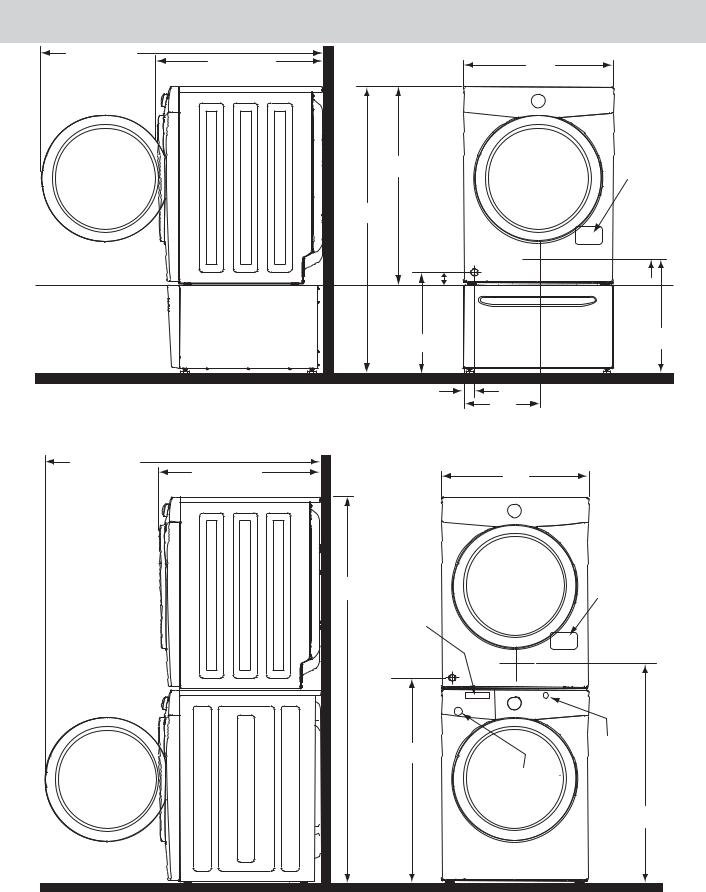
INSTALLED DIMENSIONS
51.4” (131cm) |
|
to clear open door |
30.3” (77cm)* |
to front of closed door
51.25”
(130cm)
freestand dryer on floor
floor line
dryer mounted on optional pedestal
floor line
*To obtain these minimal depth dimensions, dryer must be vented straight back. Using a quick-turn 90° elbow (right or down on freestanding dryer) adds approximately 0.75 in. (2.0 cm) to installation depth. Upward venting of exhaust on pedestal-mounted or freestanding dryer adds approximately 4 in. (10.2 cm) to installation depth. Leftward venting on pedestal-mounted or freestanding dryer adds approximately 3.75 in. (9.5 cm) to installation depth. Downward venting of exhaust on pedestal-mounted dryer adds approximately 2.25 in. (5.7 cm) to installation depth.
51.4” (131cm)
to clear open door 30.3” (77cm)*
to front of closed door
71.5”
(182cm)
27.0”
(68.5cm)
36.0”
(91.5cm)
gas supply pipe on rear of gas unit
1.6”
(4cm)
16.9”
(43cm)
3.75”
(9.5cm) 13.50” (34.5cm)
to center of rear vent
27.0”
(68.5cm)
water supply connection on rear of unit1
gas supply pipe on rear of gas unit
37”
(94cm)
drain hose on rear of unit3
electrical supply on rear of unit
centerline height for rear vent
3.7” (9.5cm) 
19.0”
(48cm)
electrical supply on rear of unit
centerline height for rear vent
power cord on rear of unit2
39”
(99cm)
*To obtain these minimal depth dimensions, dryer must be vented straight back. Using a quick-turn 90° elbow (right) adds approximately 0.75 in. (2 cm) to installation depth. Upward venting of exhaust on stacked dryer adds approximately 4 in. (10.2 cm) to installation depth. Downward venting of exhaust on stacked dryer adds approximately 2.25 in. (6.5 cm) to installation depth. Leftward venting of exhaust on stacked dryer adds approximately 3.75 in. (9.5 cm) to installation depth.
1Hot and cold inlet hose length approximately 43 inches (109cm) 2Power supply cord length approximately 60 inches (152.5cm).
3Drain hose length approximately 52 inches (132cm). |
11 |
|
|
||
|
|
|
|
|
|
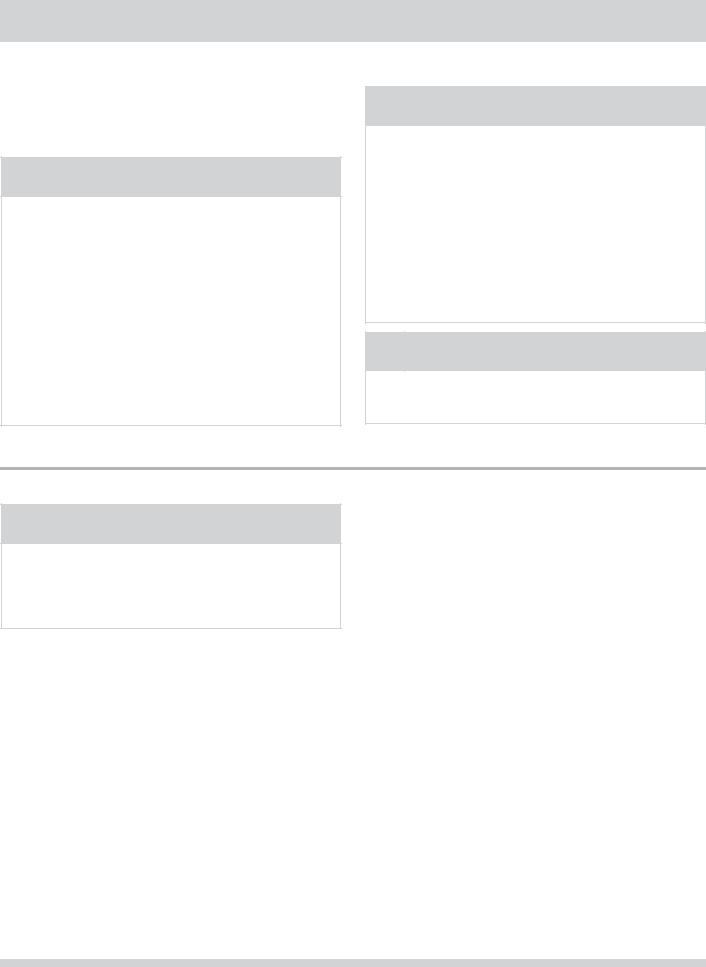
INSTALLATION INSTRUCTIONS
Electrical installation
The following are specific requirements for proper and safe electrical installation of your dryer. Failure to follow these instructions can create electrical shock and/or a fire hazard.

 WARNING
WARNING
ELECTRICAL SHOCK HAZARD
•This appliance MUST be properly grounded. Electrical shock can result if the dryer is not properly grounded. Follow the instructions in this manual for proper grounding.
•Do not use an extension cord with this dryer. Some extension cords are not designed to withstand the amounts of electrical current this dryer utilizes and can melt, creating electrical shock and/
or fire hazard. Locate the dryer within reach of the receptacle for the length power cord to be
purchased, allowing some slack in the cord. Refer to the pre-installation requirements in this manual for the proper power cord to be purchased.

 WARNING
WARNING
ELECTRICAL SHOCK HAZARD
•A U.L.-approved strain relief must be installed onto power cord. If the strain relief is not attached, the cord can be pulled out of the dryer and can be cut by any movement of the cord, resulting in electrical shock.
•Do not use an aluminum wired receptacle with a copper wired power cord and plug (or vice versa). A chemical reaction occurs between copper and aluminum and can cause electrical shorts. The proper wiring and receptacle is a copper wired power cord with a copper wired receptacle.
NOTE
Dryers operating on 208 volt power supply will have longer drying times than dryers operating on 240 volt power supply.
Grounding requirements - Electric dryer (USA)

 WARNING
WARNING
ELECTRICAL SHOCK HAZARD
Improper connection of the equipment grounding conductor can result in a risk of electrical shock. Check with a licensed electrician if you are in doubt as to whether the appliance is properly grounded.
For a grounded, cord-connected dryer:
1The dryer MUST be grounded. In the event of a malfunction or breakdown, grounding will reduce the risk of electrical shock by a path of least resistance for electrical current.
2After you purchase and install a 3 wire or 4 wire power supply cord having an equipment-grounding conductor and a grounding plug that matches you
wiring system, the plug MUST be plugged into an appropriate, copper wired receptacle that is
properly installed and grounded in accordance with all local codes and ordinances. If in doubt, call a licensed electrician.
3DO NOT modify the plug you’ve installed on this appliance. If it will not fit the outlet, have a proper outlet installed by a qualified electrician.
For a permanently connected dryer:
1The dryer MUST be connected to a grounded metal, permanent wiring system; or an equipment grounding conductor must be run with the circuit conductors and connected to the equipmentgrounding terminal or lead on the appliance.
12

INSTALLATION INSTRUCTIONS
Grounding requirements - Electric dryer (Canada)

 WARNING
WARNING
ELECTRICAL SHOCK HAZARD
Improper connection of the equipment grounding conductor can result in a risk of electrical shock. Check with a licensed electrician if you are in doubt as to whether the appliance is properly grounded.
For a grounded, cord-connected dryer:
1The dryer MUST be grounded. In the event of a malfunction or breakdown, grounding will reduce
the risk of electrical shock by a path of least resistance for electrical current.
2Since your dryer is equipped with a power supply cord having an equipment-grounding conductor and a grounding plug, the plug must be plugged into an appropriate outlet that is properly installed and grounded in accordance with all local codes and ordinances. If in doubt, call a licensed electrician.
3DO NOT modify the plug provided with this appliance. If it will not fit the outlet, have a proper outlet installed by a qualified electrician.
Grounding requirements - Gas dryer (USA and Canada)
1The dryer is equipped with a three-prong (grounding) plug for your protection against shock hazard and should be plugged directly into a properly grounded three-prong receptacle.
2The plug must be plugged into an appropriate outlet that is properly installed and grounded in accordance with all local codes and ordinances. If in doubt, call a licensed electrician.
3DO NOT modify the plug provided with this appliance. If it will not fit the outlet, have a proper outlet installed by a qualified electrician.
Grounding type wall receptacle
Do not, under
any circumstances, cut, remove,
or bypass the grounding prong.
Power cord with 3-prong grounded plug
13

INSTALLATION INSTRUCTIONS
Gas connection
1Remove the shipping cap from gas pipe at the rear of the dryer.

 IMPORTANT
IMPORTANT
DO NOT connect the dryer to L.P. gas service without converting the gas valve. An L.P. conversion kit must be installed by a qualified gas technician.
2Connect a 1/2 inch (1.27 cm) I.D. semi-rigid or approved pipe from gas supply line to the 3/8 inch (0.96 cm) pipe located on the back of the dryer. Use a 1/2 inch to 3/8 inch (1.27 cm to 0.96 cm) reducer for the connection. Apply an approved thread sealer that is resistant to the corrosive action of liquefied gases on all pipe connections.
Manual |
Flare |
GAS FLOW |
Flare |
Shutoff |
|
||
Union |
|
Union |
|
Valve |
|
||
|
|
|
|
Closed |
|
|
|
Nipple |
Flexible |
Inlet Pipe on |
|
Open |
|
Connector |
Back of Dryer |
All connections must be wrench-tightened

 IMPORTANT
IMPORTANT
The supply line must be equipped with an approved manual shutoff valve. This valve should be located in the same room as the dryer and should be in a location that allows ease of opening and closing. Do not block access to the gas shutoff valve.
3Open the shutoff valve in the gas supply line to allow gas to flow through the pipe. Wait a few minutes for gas to move through the gas line.
 to dryer
to dryer
from |
gas |
supply |
|
||
|
|
Shutoff Valve -
Open position
4Check for gas system leaks with a manometer. If a manometer is not available, test all connections by brushing on a soapy water solution.

 WARNING
WARNING
EXPLOSION HAZARD
NEVER test for gas leaks with an open flame.
14
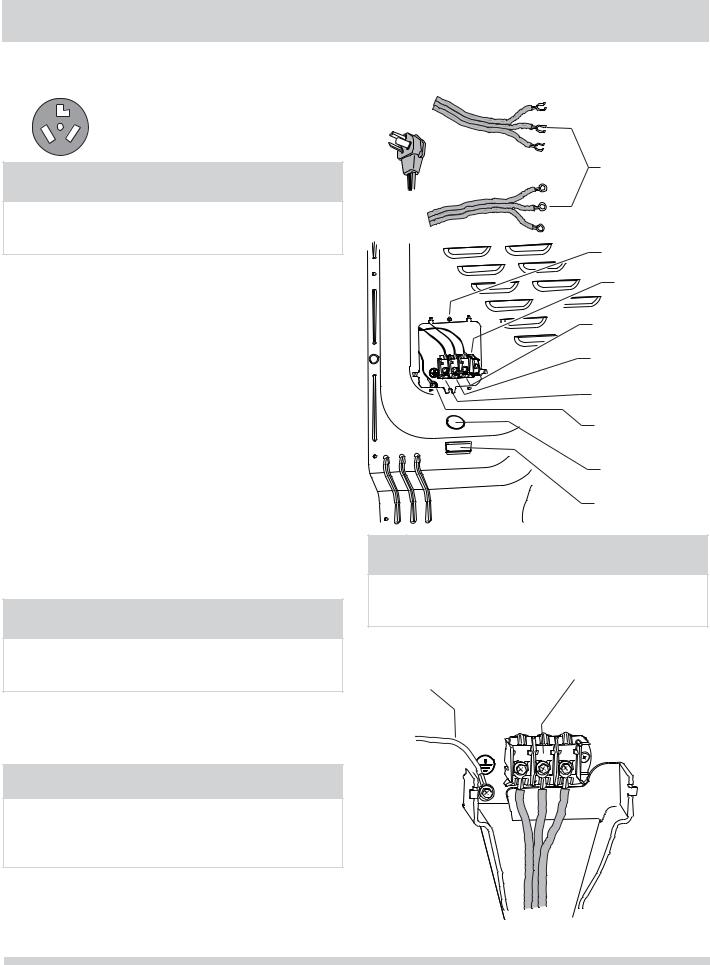
INSTALLATION INSTRUCTIONS
Electrical connection (non-Canada) - 3 wire cord
3-wire receptacle (NEMA type 10-30R)

 WARNING
WARNING
ELECTRICAL SHOCK HAZARD
Failure to disconnect power source before servicing could result in personal injury or even death.
1Turn off power supply to outlet.
2Remove the screw securing the terminal block access cover in the lower corner on the back of the dryer.
3Install a UL-approved strain relief according to the power cord/strain relief manufacturer’s instructions in the power cord entry hole below the access panel. At this time, the strain relief should be loosely in place.
4Thread an UNPLUGGED, UL-approved, 30 amp. power cord, NEMA 10-30 type SRDT, through the strain relief.
5Attach the power cord neutral (center wire) conductor to the SILVER colored center terminal on the terminal block. Tighten the screw securely.
6Attach the remaining two power cord outer conductors to the outer, BRASS colored terminals on the terminal block. Tighten both screws securely.

 WARNING
WARNING
ELECTRICAL SHOCK HAZARD
Do not make a sharp bend or crimp wiring/conductor at connections.
7Follow manufacturer’s guidelines for firmly securing the strain relief and power cord.
8Reinstall the terminal block cover.

 IMPORTANT
IMPORTANT
If moving dryer from a 4-wire system and installing it in a 3-wire system, move the internal ground from the center terminal back to the GREEN screw next to the terminal block.
30 AMP |
|
NEMA 10-30 |
Neutral |
|
(center wire) |
Access cover
screw
Terminal
block
Line 2
(BRASS terminal)
Neutral (SILVER terminal)
Line 1
(BRASS terminal)
Internal ground
(GREEN screw)
Install
UL-approved strain relief here
Terminal screw recovery slot
NOTE
If a terminal screw falls during cord installation, it can be retrieved in the terminal screw recovery slot below the access panel.
DO NOT remove internal ground in
Neutral
a 3-wire system!!
terminal
15
